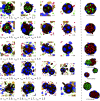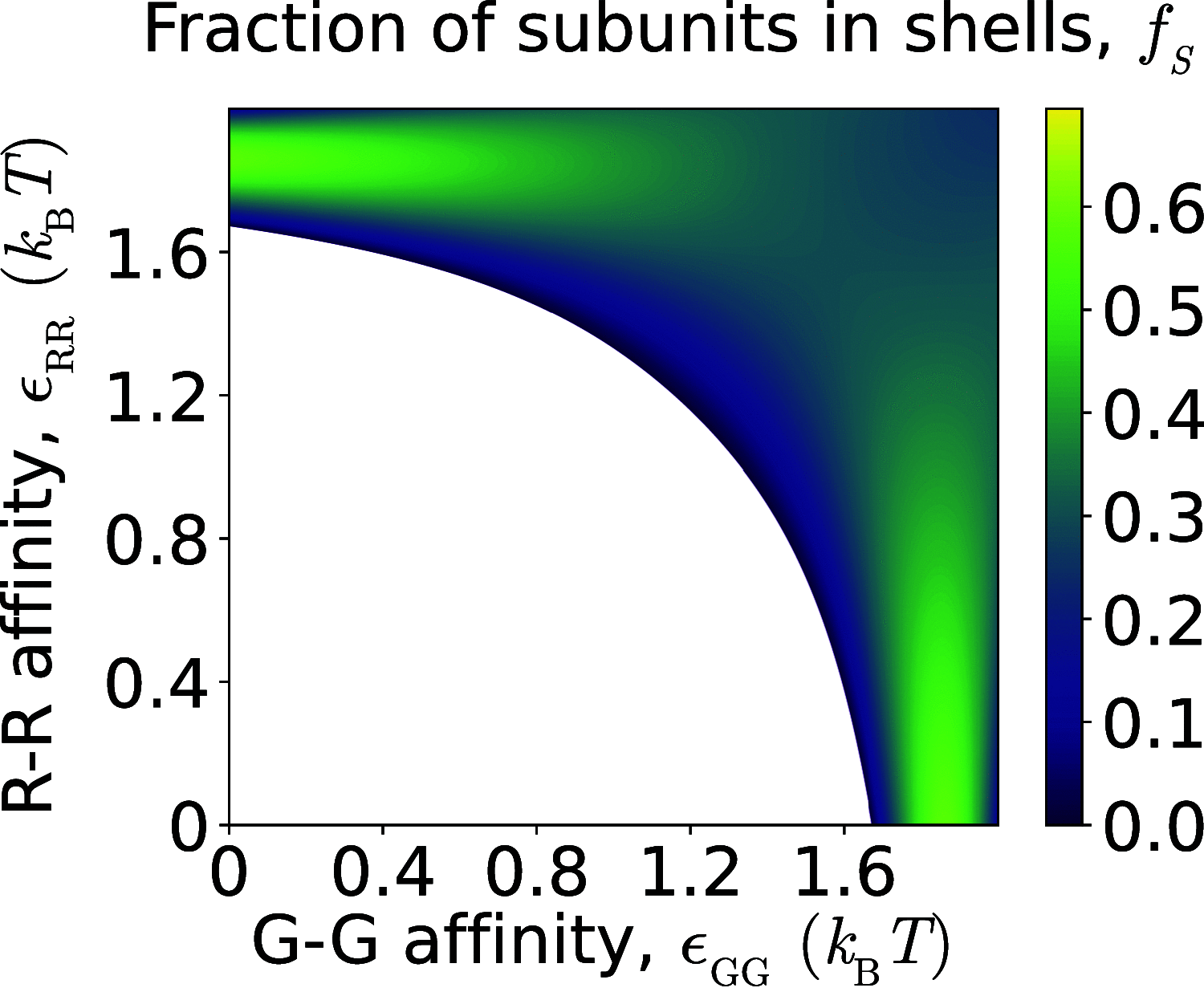Microcompartment assembly around multicomponent fluid cargoes
- PMID: 35778087
- PMCID: PMC9249432
- DOI: 10.1063/5.0089556
Microcompartment assembly around multicomponent fluid cargoes
Abstract
This article describes dynamical simulations of the assembly of an icosahedral protein shell around a bicomponent fluid cargo. Our simulations are motivated by bacterial microcompartments, which are protein shells found in bacteria that assemble around a complex of enzymes and other components involved in certain metabolic processes. The simulations demonstrate that the relative interaction strengths among the different cargo species play a key role in determining the amount of each species that is encapsulated, their spatial organization, and the nature of the shell assembly pathways. However, the shell protein-shell protein and shell protein-cargo component interactions that help drive assembly and encapsulation also influence cargo composition within certain parameter regimes. These behaviors are governed by a combination of thermodynamic and kinetic effects. In addition to elucidating how natural microcompartments encapsulate multiple components involved within reaction cascades, these results have implications for efforts in synthetic biology to colocalize alternative sets of molecules within microcompartments to accelerate specific reactions. More broadly, the results suggest that coupling between self-assembly and multicomponent liquid-liquid phase separation may play a role in the organization of the cellular cytoplasm.
Figures








Similar articles
-
The role of the encapsulated cargo in microcompartment assembly.PLoS Comput Biol. 2018 Jul 31;14(7):e1006351. doi: 10.1371/journal.pcbi.1006351. eCollection 2018 Jul. PLoS Comput Biol. 2018. PMID: 30063715 Free PMC article.
-
Mechanisms of Scaffold-Mediated Microcompartment Assembly and Size Control.ACS Nano. 2021 Mar 23;15(3):4197-4212. doi: 10.1021/acsnano.0c05715. Epub 2021 Mar 8. ACS Nano. 2021. PMID: 33683101 Free PMC article.
-
Kinetic Growth of Multicomponent Microcompartment Shells.ACS Nano. 2023 Aug 22;17(16):15751-15762. doi: 10.1021/acsnano.3c03353. Epub 2023 Aug 8. ACS Nano. 2023. PMID: 37552700
-
The protein shells of bacterial microcompartment organelles.Curr Opin Struct Biol. 2011 Apr;21(2):223-31. doi: 10.1016/j.sbi.2011.01.006. Curr Opin Struct Biol. 2011. PMID: 21315581 Free PMC article. Review.
-
Ethanolamine bacterial microcompartments: from structure, function studies to bioengineering applications.Curr Opin Microbiol. 2021 Aug;62:28-37. doi: 10.1016/j.mib.2021.04.008. Epub 2021 May 24. Curr Opin Microbiol. 2021. PMID: 34034083 Review.
Cited by
-
Modeling bacterial microcompartment architectures for enhanced cyanobacterial carbon fixation.Front Plant Sci. 2024 Feb 15;15:1346759. doi: 10.3389/fpls.2024.1346759. eCollection 2024. Front Plant Sci. 2024. PMID: 38425792 Free PMC article. Review.
-
In Vitro Analysis of Bacterial Microcompartments and Shell Protein Superstructures by Confocal Microscopy.Microbiol Spectr. 2023 Feb 14;11(2):e0335722. doi: 10.1128/spectrum.03357-22. Online ahead of print. Microbiol Spectr. 2023. PMID: 36786617 Free PMC article.
References
-
- Brangwynne C. P., Tompa P., and Pappu R. V., “Polymer physics of intracellular phase transitions,” Nat. Phys. 11, 899–904 (2015).10.1038/nphys3532 - DOI
MeSH terms
Substances
Grants and funding
LinkOut - more resources
Full Text Sources

